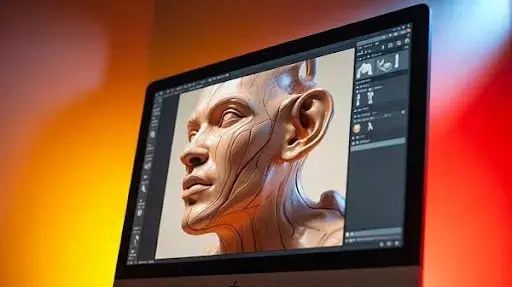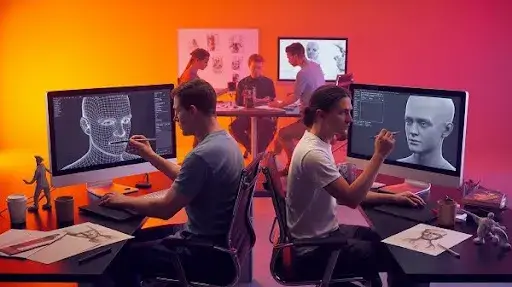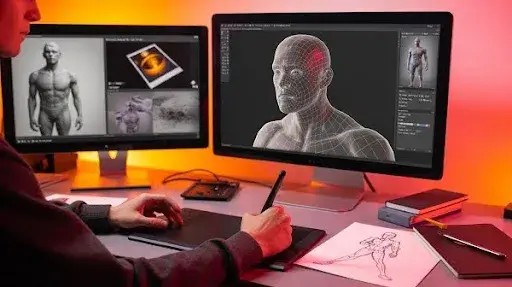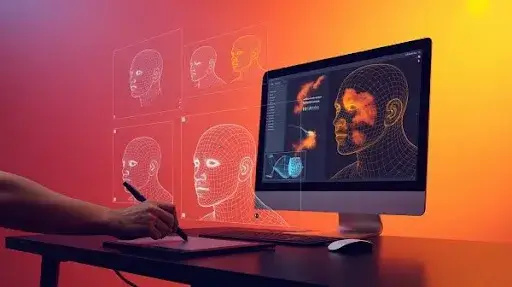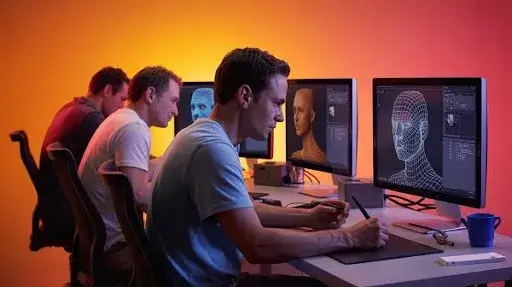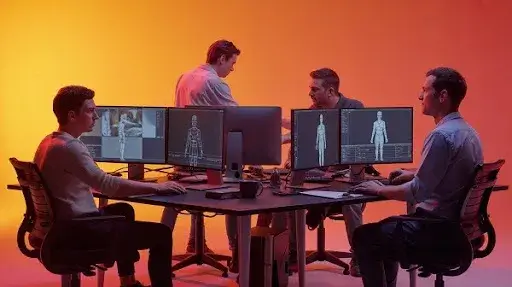3D sculpting is where ideas stop floating in your head and start taking form. Every detailed game hero, every cinematic creature, every ultra-real product render that looks like you could pick it up, all of it begins here, with digital clay. It’s that meeting point between imagination and reality.
People no longer get impressed by polished visuals alone. They crave authenticity, emotion, texture, something that feels alive. That’s what 3D sculpting brings to digital art. It turns lifeless shapes into believable forms that carry presence and attitude.
For artists, brands, and studios, knowing how to use 3D sculpting tools isn’t optional anymore. It’s part of how visuals get their soul.
What Is 3D Sculpting
Think of 3D sculpting like working with real clay, but without the mess and cleanup. You still push, pull, pinch, and smooth. You just do it inside software instead of with your hands. Little by little, that flat 3D surface starts to feel alive.
Unlike traditional modeling, sculpting is emotional. It’s not about geometry; it’s about personality. You’ll notice it in the wrinkles around a grin, the subtle pores on a creature’s skin, or the tension across a hand that’s gripping too hard. Those tiny imperfections make everything more believable.
Digital sculpting captures that. It’s not chasing mechanical precision; it’s chasing the human touch.
At Prolific Studio, the most creative projects begin with sculpting, whether they are animated commercials, 3D game assets, or high-end 3D modeling services. This is how the ideas become visualized, both handcrafted and digital.
3D Sculpting vs Modeling
People often confuse sculpting and modeling, but they work very differently.
Modeling is about structure, building with polygons, edges, and vertices. It’s clean, mathematical, and great for technical designs like machinery, vehicles, or architecture. That’s where hard surface sculpting comes into play.
Because sculpting is more liquid and freeform, there is no need to think about numbers and grids, or to form shapes. It is as intuitive and expressive as molding clay with your fingers. These characteristics are great for organic modeling and sculpting.
Once a sculpt is done, artists usually do retopology after sculpting to tidy up geometry and make sure the model runs smoothly in animation or rendering.
At Prolific Studio, we mix both approaches. We start with a rough model to lock proportions, move to sculpting for the personality and texture, then refine everything with modeling. That back-and-forth makes the final piece solid yet full of life.
How 3D Sculpting Shapes Modern Creative Industries
3D sculpting doesn’t just live inside art programs, it powers some of the biggest creative industries. From games to advertising, it’s the foundation for visual storytelling that feels real and emotional.
1. Sculpting for Games
In games, every pixel counts. Players can appreciate the difference when game characters are designed with believable body structures, muscle tension, and even small flaws. Sculpting allows artists to make hyper-detailed high-poly game models, including scars, folds, and other textures, down to tiny scratches on metal surfaces.
Once the models are made, they are optimized to lighter low-poly versions for real-time gameplay.
At Prolific Studio, we treat sculpting like storytelling. Every character or creature carries clues about its world, a chipped sword, worn boots, or tired eyes. These things don’t happen by accident; they’re sculpted in.
That’s what separates a simple model from a character that feels alive.
2. Sculpting for 3D Printing
3D printing turned digital sculpting into something you can literally hold. What starts as a sketch on-screen can become a tangible object in a few hours.
In 3D design and sculpting, designers can make and use 3D prints for all kinds of stuff; in addition to miniature collectible figures, they can use it for jewelry, furniture prototypes, and even models with medical and engineering applications.
Digital clay modeling allows them to design and create iterations, and 3D prints can be produced to test the designs. No wasted materials, no delays, just pure creativity and iteration.
It is both creative freedom and efficiency for design teams. They can test ergonomics, adjust proportions and dimensions based on client feedback, and eliminate the need for traditional iterations and prototypes.
3. 3D Sculpting for Product Design
When it comes to 3D modeling services, sculpting adds polish and feeling. Modeling sets up the structure, but sculpting gives it touch and soul. It’s how a perfume bottle looks elegant, how a gadget feels balanced, or how packaging subtly catches light.
The quality of surface finishing determines how lifelike the transition and microtextures are in a render. Photo-realistic-quality renders feature sculptors on the surface finish. These are powerful tools for a brand when presenting concepts to potential investors or the target audience, even before prototypes are created.
For companies, that means saving costs and creating excitement early. A detailed digital sculpt sells the idea before the real product exists.
4. Sculpting for Animation and Advertising
Animation and advertising both rely on visuals that make people feel something. Sculpting helps achieve that emotional pull.
In film, a sculpted character can show fatigue, softness, or strength through subtle details. In advertising, sculpted 3D visuals give digital products a crafted, handmade charm that connects with people instantly.
At Prolific Studio, our artists digitally sculpt with 3D sculpting software, creating a realism that remains human. Every design is perfected with a human touch, thanks to the warm realism created by modest elements such as slight imperfections, a dent, a fingerprint, and a pronounced crease.
Inside the 3D Sculpting Workflow
Sculpting looks spontaneous, but it follows a careful rhythm. The 3D sculpting workflow balances creative flow with technical control.
- Concept & Base Mesh: Build a rough model to lock in proportions.
- Pushing/Pulling Geometry: Use sculpting brushes to stretch, pinch, and define volume.
- Anatomy Sculpting: Add structure underneath, bone, muscle, or mechanical layers.
- Surface Detail Sculpting: Carve textures, pores, scratches, and realistic imperfections.
- High-Poly Modeling: Refine mesh for maximum visual detail.
- Retopology After Sculpting: Reorganize geometry for animation or optimization.
- Texture, Rigging, and Animation After Sculpting: Add color, movement, and realism.
Every phase connects creativity to production. Sculptors and modelers keep refining until the digital sculpture feels natural and ready for the 3D asset production pipeline.
Most Used 3D Sculpting Software
Every sculptor has their go-to tools, but a few programs dominate the field:
- ZBrush: The top pick for anatomy sculpting and high-resolution detail.
- Blender: Free, open-source, and capable of everything from modeling to rendering.
- Mudbox: Ideal for texturing and compatible with Autodesk systems.
- 3D-Coat: Great for voxel sculpting and advanced painting.
- Meshmixer: Useful for prepping sculpting for 3D printing.
- Maya & 3DS Max: Primarily modeling software, but great for hybrid workflows.
This software allows the artist to switch seamlessly between voxel sculpting and mesh sculpting. While voxel sculpting is often used for creating freedom, surface sculpting for precision, many professionals use a balance of both.
Common Sculpting Techniques for 3D Artists
Every artist develops their own rhythm, but some sculpting techniques always show up:
- Blocking: Building basic form before fine detail.
- Dynamic Tessellation: Adding detail where needed instead of everywhere.
- Symmetry Sculpting: Making edits on one side that mirror to the other.
- Masking & Extracting: Isolating areas to focus on details.
- Brush Sculpting: Custom brushes for folds, wrinkles, or surface texture.
Sculpting blends instinct with control. It’s craftsmanship in a digital space, each stroke, pull, and polish telling a story of its own.
Challenges and the Learning Curve in 3D Sculpting
3D sculpting does seem hypnotizing at first with all the brushes, freedom to create, and the clay-like shapes. The software does offer a lot, but there is a real mental hurdle in sculpting and that is training the mind to perceive form, flow, and weight.
It’s funny how beginners often think it’s all about tools. They spend days adjusting brushes or chasing tutorials instead of learning how light wraps around a cheekbone or how tension moves across a folded surface. That’s where real sculpting lives, not in shortcuts, but in observation.
Artists who’ve played with actual clay or done figure sketches usually pick it up faster. That tactile sense, the feel of pressure and curve, gives life to their digital work. You can almost sense when someone has that background; their models breathe.
Our team at Prolific Studio follows that same line of thought. We mix old-school art instincts with the precision of modern tools. For us, a sculpt doesn’t end when it looks technically correct. It ends when it feels believable, when posture, rhythm, and subtle balance fall into place before any surface details even start.
The Role of 3D Sculpting in a Production Pipeline
Think of a sculpt as a bridge between an idea and a finished asset. It’s not the end of the process but the point where everything starts connecting: concept, modeling, texturing, animation, and final render.
Retopology and Cleanup
Once the sculpt becomes high-poly, it’s loaded with millions of polygons. That’s too heavy for animation. Retopology helps rebuild the shape into a lighter version while keeping all the charm and character intact. This step keeps the 3D asset production pipeline running smooth.
UV Mapping and Texturing
Then comes the fun but tedious part, texturing. Artists unwrap the sculpt with UV mapping so textures can sit perfectly on the surface. Every scratch, bump, or pore is painted to give it personality. It’s a strange mix of creativity and math, but when it clicks, the result looks natural.
Rigging and Animation
After that, the model needs to move. Rigging adds bones and joints so animators can bring it to life. For sculpting in animation projects, it’s smart to think ahead, plan the bends and movements before the sculpt even ends. It saves a lot of rework later.
Rendering and Lighting
Lighting is where it all comes alive. It defines the tone and mood of your sculpt. The right lighting setup can turn a decent model into something cinematic. That’s why lighting plays a huge role in 3D modeling services. It adds realism, texture, and depth, the kind that catches the eye immediately.
Each of these stages blends technical accuracy with artistic sense. Together, they turn raw sculpts into finished, believable assets that fit seamlessly into animation, film, or product pipelines.
Why 3D Sculpting Services Are So Valuable
It’s no secret, people scroll fast, skip faster, and only stop for something that feels real. That’s where 3D digital sculpting shines. It captures the kind of detail that makes people pause.
Here’s what makes it so valuable:
- Details feel alive. Wrinkles, pores, and skin folds give the work emotion that plain modeling can’t.
- Faster than physical prototypes. You can explore multiple versions, tweak, or redesign before even touching manufacturing.
- Shorter marketing cycles. Using sculpting for product design means ads and visuals can be ready before the product itself exists.
- Creative freedom. Digital clay doesn’t dry, crack, or crumble. Artists can shape anything, even what can’t exist in real life.
The real win here isn’t just accuracy. It’s emotion. People connect with visuals that carry a handmade warmth, and digital sculpting, done right, delivers exactly that.
Sculpting Across Art Styles
Not every sculpt needs to look hyper-realistic. Stylized 3D sculpting can be more stimulating to work on. It is often more playful, with disproportioned features like oversized eyes, expanded limbs, and simplified shapes. The emotions that said forms bear are more than real restrain could capture.
You see it in animated movies, indie games, or branding mascots. They may not look “real,” but they make you feel something, and that’s the whole point.
At Prolific Studio, our artists move between these worlds with ease. Some projects call for lifelike anatomy and textured armor. Others need friendly, rounded characters that feel playful. Mixing both lets us balance credibility with storytelling.
How AI Is Changing 3D Sculpting
Leveraging AI and tools on 3D sculpting for tasks like retopology, building material, and brush automation offers artists a competitive edge. It creates a new paradigm in sculpting by reducing time spent on repetitive tasks, thereby increasing the time available for creative exploration.
That said, AI doesn’t understand emotion or weight. It can’t sense when a form feels off or when a pose lacks tension. Those things still come from human instinct.
Our team at Prolific Studio treats AI as a helpful assistant, not a replacement. It’s great for speeding up the 3D sculpting workflow, but the final judgment, the feeling, stays with the artist. That’s the part no code can replicate.
The Future of 3D Sculpting
Digital sculpting keeps moving forward fast. VR sculpting now lets artists work in a full 3D space, while voxel sculpting tools add freedom that feels almost like shaping real clay. And because of open platforms like Blender, ZBrush, and Nomad Sculpt, anyone can jump in, no massive studio setup required.
That shift is huge. It’s bringing more collaboration, more experimentation, and faster turnarounds for studios like ours. The exciting part? It’s still driven by human hands.
No matter how advanced the tools get, emotion still wins. Sculptors who understand gesture and rhythm will always stand out, because machines can’t fake feeling.
Frequently Asked Questions
What makes 3D sculpting different from regular modeling?
Modeling focuses on structure and geometry. Sculpting is more about form, rhythm, and feel, closer to working with clay than setting up polygons.
How is sculpting used in games or animation?
Artists sculpt high-detail models and then simplify them to run efficiently in real-time engines. The result keeps depth and style without hurting performance.
Which industries rely on 3D sculpting the most?
Beyond gaming and film, 3D sculpting uses extend into product design, architecture, fashion, and advertising, anywhere visuals need personality and realism.
Can sculpted models be turned into physical items?
Yes. Sculpting for 3D printing lets digital models become real, from collectibles to wearable pieces or product prototypes.
What’s the best sculpting software for beginners?
ZBrush remains the go-to for pros, but Blender is an amazing free option that covers modeling, sculpting, and rendering all in one.
Final Words
3D sculpting isn’t just a technical process. It’s an art form that blends emotion, logic, and design sense. Every push or pull on digital clay adds more story to the piece.
From sculpting for games to 3D modeling services, it’s now at the center of how modern visuals are built. It connects human imagination with technology in a way few other fields can.
At Prolific Studio, every sculpt starts as a raw thought and grows into something real, shaped by hands that understand balance and life. Because in the end, sculpting isn’t only about creating objects. It’s about shaping ideas people can feel.
Related Articles:

